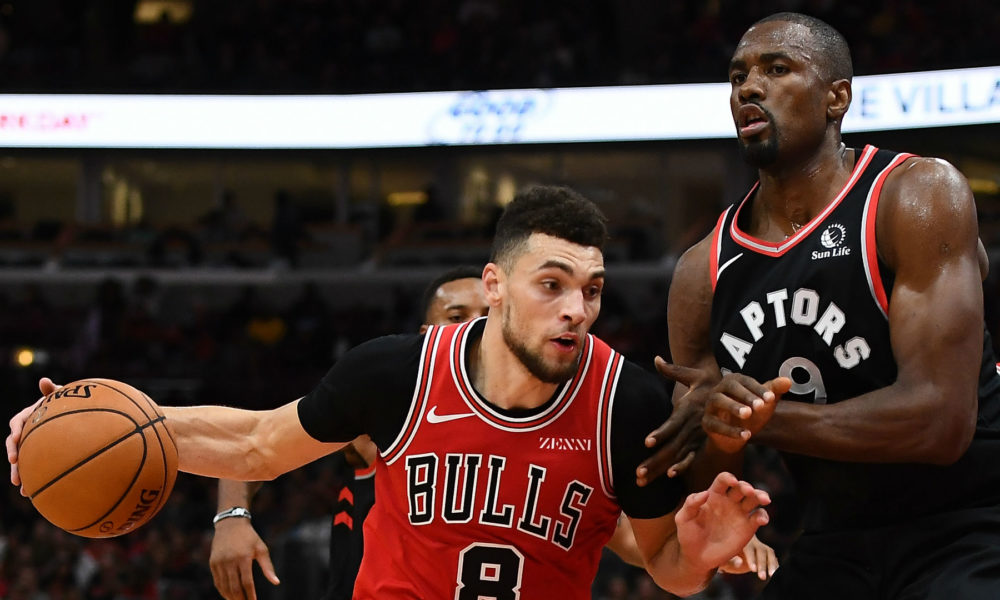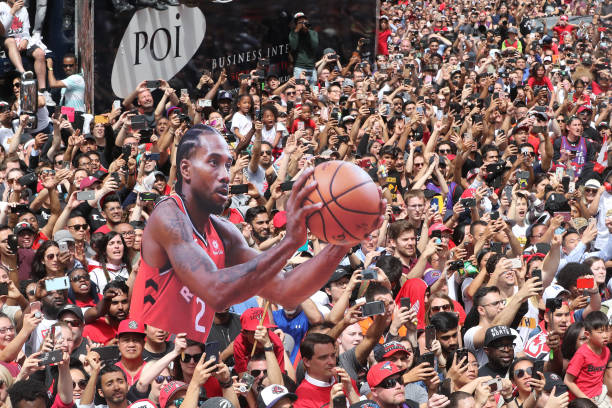The Raptors season has been doused with a dose of reality over the past week. Toronto endured their first three game losing streak since November of last year, all of which came against opponents that figure to feature prominently in the playoff picture. Their record against over .500 opponents now sits at a pedestrian 6-7, yet they remain undefeated against under .500 competition. Toronto can out-talent, out-work, and out-defend inferior opponents— their depth and coaching quality allows them to absorb a 3-for-15 shooting night from Kyle Lowry and still beat the Chicago Bulls— but these traits alone do not suffice against the league’s best.
Toronto’s current 16-7 standing still remains an incredibly impressive feat. They have endured a slew of injuries to key players, impressed during a slog of a western road trip, and have remained within five points with five minutes remaining in every single one of their losses. However, there is more to be gleaned from a loss against Miami than another blowout victory against New York, and thus performances against stiffer competition should analyzed more shrewdly.
Toronto can be a championship contender come April (well, that Greek fella in Milwaukee may have other plans) but they must address the issues that have befell them against future playoff opponents so far this season.
Note: These stats were accumulated prior to the Chicago Bulls game on Dec. 9
Defence wins championships regular season games
The major reason that the Raptors have constantly hung around in every game this year is because of their team defence. The unit unlocked a new level during last year’s playoff run and have maintained that stifling persona this season. Regardless of the competition, Toronto have made their opponent’s life hell. It is the foundational block that they have built their continued success on.

The Raptors are the sixth ranked defence and are tops in opponent effective field goal percentage. An important feature of this has been the ability to deny their opponents easy shots around the rim. Milwaukee are the only team in the league better at not only dissuading opponents from shooting at the rim, but also shooting less efficiently. Granted, stronger teams possess more offensive talent and are executing better against Toronto, but not by much. They are still held below league average in each of the above statistical categories.
This is a testament to how well the the Raptors know where not to let their opponents shoot. Toronto possesses many quick and switchable perimeter defenders that rarely get beat at the point of attack. When they do, help defenders arrive quickly to either deter a shot from occurring inside or at least make the attempt plenty difficult. Sometimes they even manage to accomplish both of these results in one possession:
Toronto’s defensive flaws also remain consistent against differing quality of opposition. Twenty-four seconds of frenetic defensive synchronicity means naught if a team is unable to close the possession out, and boy, do the Raptors hate closing possessions out. They are a poor defensive rebounding team, posting a paltry 70.42% defensive rebounding rate. Only the Atlanta Hawks— who are anchored by the imposing frontcourt duo of Damian Jones and Jabari Parker— rank worse. The Raptors are currently allowing teams above .500 and below .500 to corral 17.1 and 14.7 offensive boards per game respectively, far exceeding the league average of 10.2.
The nature of Nick Nurse’s aggressive, and sometimes unconventional, defences has attributed to Toronto’s rebounding woes. Hard double teams, traps, and zone defence make it far more difficult for rebounders to locate specific players to box-out. The net result of these schemes has been successful, but they do compromise the team in certain areas.
The hard double teams that the Raptors send to nullify the opponent’s best offensive weapon and the subsequent scrambling to pack the paint enables a hefty portion of opposition three-point attempts. At one point Toronto were leading the league in opponent three-point percentage, however that looks to be the result of variance and playing Orlando three times as their ranking has begun to normalize. Allowing three-point attempts isn’t necessarily a bad thing; the Bucks (I’m sorry for referring to them, but they are the league’s benchmark this season) allow a boatload of them but force a vast majority of the shots from above the break, a far harder look than from the corner. In contrast, Toronto are leading the league in opponent corner three-point attempts— a stat that nobody wants to be the leader of. Again, it isn’t the top teams carving them apart to generate these shots, Toronto are uniformly allowing these looks.

Toronto’s strengths and weaknesses on defence remain steadfast irrespective of their opponents. Their offence, however, has proven to be a different story.
Diversifying the offence
Under the guidance of Nick Nurse, both as an assistant and then head coach, the Raptors have modernized their offensive style. Their shot profile indicates as such and, while they aren’t taking it to the extreme of the Houston Rockets, Nurse has implemented an efficient shot distribution combined with the flowing style of offence that he prefers.
However, as anyone who remembers all the moments in the Philadelphia series besides ‘the shot’, scoring efficiently with threes, free-throws, and layups, isn’t that easy against the top defences. This season, Toronto has been forced into tougher looks by stronger opposition and their efficiency in those areas dips, a doubly bad outcome.

The difference in the frequency and accuracy of the Raptors’ three-point shooting pending on their opponents is negligible and sits above the league average marks, even amidst regression during the recent slump. However, Toronto are trading shots at the rim for mid-range jumpers against better teams, and shooting those looks at an 11 per cent worse rate. That is a sizable difference.
There are only two players on the Raptors team who take less than 70 per cent of their shots at the rim or from three, Pascal Siakam (66.6%) and Serge Ibaka (45%). This is the norm for Ibaka throughout his career as a pick-and-pop shooter; his rough 39.4 per cent shooting from the mid-range this year is currently hurting Toronto, but there is optimism that upwards regression will kick in once he finds his groove returning from injury.
Siakam, however, is new to the mid-range world. Last year, just over 2 per cent of his shots came from between 14 feet and the three-point line, yet this season that number has ratcheted up to almost 10 per cent as Siakam has assumed the role of go-to scorer for Toronto. Despite his early Kawhi impersonations, Siakam has cooled off from that range, now only connecting on 37.2 per cent of those shots.
Team’s best scorers often have to take a larger portion of mid-range shots. They are the guys that the ball goes to when possessions run awry, when the shotclock buzzer approaches, and in game-winning moments. Siakam has exceeded all expectations as the offensive star and will continue to take mid-range shots, but it would behoove the Raptors use him more dynamically now that opposing defences are focused on stopping him. Siakam currently uses the fifth most isolation possessions per game and is only scoring in the 53rd percentile with a 41.5 effective field goal percentage. He has stumbled into some trouble when faced with elite one-on-one defenders such as Bam Adebayo, Anthony Davis, and Al Horford.
https://streamable.com/1ojp7
It isn’t a coincidence that the above mid-range misses came against strong post defenders. Siakam feasts in post-up situations, but if he can’t exploit his match-up there then he increasingly turns to those long isolation jumpshots. Static iso possessions are not what make Siakam special. He is an assortment of limbs, overflowing energy, poetic footwork, and blurring speed; it is restrictive to confine him to such rote possessions.
Nurse should emphasize getting Siakam the ball on the move or in plays that force his defender into quick decision-making scenarios. If the defender makes the incorrect read, Siakam punishes them. If they take too long in their decision, Siakam punishes them. Trading in a few of those isolation possessions for pick-and-roll actions with smaller guards in Lowry and VanVleet may be a nice trade-off.
As the roller in pick-and-pop scenarios, Siakam has looked far more comfortable shooting the ball from mid-range. In those catch-and-shoot looks Siakam has a more stable base and leans on the form of his reworked shooting mechanics. Both VanVleet and Lowry are also deft deliverers of those passes. There is room for Siakam to pop more regularly to behind the arc in these actions now that he has proven to be a dependable marksman from above the break. There have been a few examples of Siakam executing a quick hand-off to VanVleet and screening at the top of the arc and it has offered the guard a free runway to get downhill to the hoop.
While Siakam is currently running 1.1 possessions as the roller, he is using 3.3 possessions as the pick-and-roll ballhandler. Siakam running more inverted pick-and-rolls with Lowry or VanVleet as the screener could be a fun wrinkle to increase this number. Right now Siakam’s pick-and-roll chemistry with Marc Gasol is blah. Gasol isn’t a dynamic enough of a rolling option, and Siakam doesn’t yet have a tight enough handle or the probing ability to play that cat-and-mouse game dancing around a screening big, looking for a crack to emerge. Siakam’s biggest struggles have also come against size, and using the guard as a screener minimizes the thicket of long arms waving in his direction. If the defender drops in those actions, Siakam should have the size advantage to effectively get to the rim. If they focus their attention his way, then Siakam has a dead-eye shooter from three as his first read.
https://streamable.com/udfxy
The Celtics and Bucks both frequently dropped their bigs in pick-and-roll coverage against Toronto and tempted them to settle for mid-range jumpers. They would also recover onto the ballhandler and leave Gasol wide-open from deep, daring him to launch away, something he is clearly reluctant to do. (When he does successfully the Raptors become an offensive beast, the Utah game serves as an example). Using smaller pick-and-roll actions with Siakam and a shooter may be a strong counterpunch to this conservative defensive approach.
The Raptors aren’t running some archaic style of basketball that relies on Carlos Boozer elbow jumpers. Even when forced into more mid-range attempts by top defences they sit below the league average. However, as much as Daryl Morey hates to believe it, it is still an area where the best teams need to execute. And in that regard, the Raptors have been decidedly poor. If opponents emulate the Raptors own defensive tactic and send additional bodies Siakam’s way— like Chicago did last night— then secondary scorers have to step up. Once Lowry rediscovers his offensive rhythm it should ease the burden on Siakam’s shoulders.
Teams only go as far as their star takes them, and Siakam is learning about these added responsibilities on the fly. When it comes to winning time, the Raptors new ‘max player’ will have to knock down those game-deciding shots.
All stats were taken from pbpstats.com and nba.com



